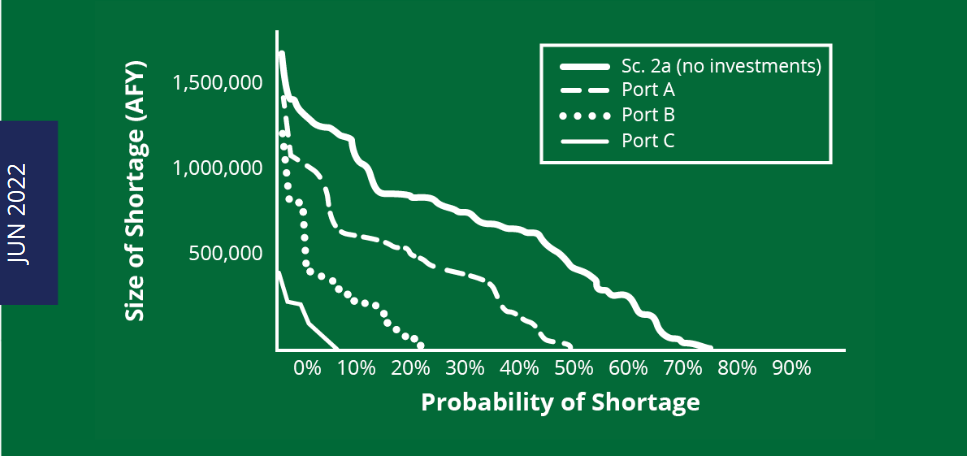At the June meeting of the Delta Stewardship Council, Dr. Jay Lund, the immediate past chair of the Delta Independent Science Board, gave a presentation on the DISB’s recently-completed Review of Water Supply Reliability Estimation Related to the Sacramento-San Joaquin Delta.
“The title of this presentation is ‘Smarter Gambling with Water,’ because much of what we’re doing with the Delta is inherently risky,” Dr. Lund said. “We don’t really know what the next year’s hydrology is going to be. We don’t know exactly what the next decade’s hydrology is going to be. We don’t know whether particular actions of any sort, be they ecosystem, restoration actions, or others, are going to behave exactly as we would hope or was as people have promised us even, because this Delta is a very complex place subject to a lot of variability.”
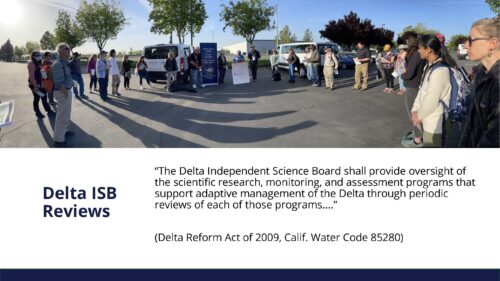 Under the Delta Reform Act, the Delta Independent Science Board is required to provide oversight and assessment of all the different aspects of Delta science.
Under the Delta Reform Act, the Delta Independent Science Board is required to provide oversight and assessment of all the different aspects of Delta science.
The water supply reliability review is the first in ten years to review one of the two co-equal goals. This being the first review, it focuses on the methods; future assessments of water supply reliability will address the science behind it.
“This is not the last word on Delta water supply reliability, but it’s maybe one of the first ones,” said Dr. Lund.
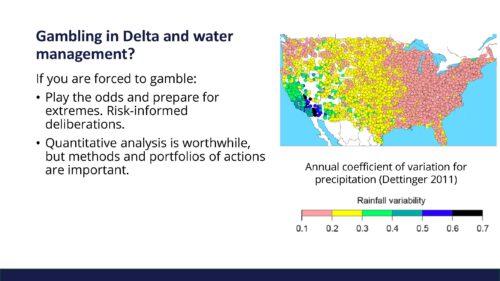 Dr. Lund presented a map showing the variability of annual precipitation. Statistically speaking, it’s called the ‘coefficient of variation’; it is calculated by dividing the standard deviation by the mean.
Dr. Lund presented a map showing the variability of annual precipitation. Statistically speaking, it’s called the ‘coefficient of variation’; it is calculated by dividing the standard deviation by the mean.
Looking at that ratio of variability to average, the eastern states have little variability; each year is mostly like the next. The variability increases somewhat moving west, but California is much more variable than the rest of the country.
“What I tell people about this map is that California has more flood years and drought years per average year than any other part of the country,” he said. “This is very important for federal officials to understand; it’s very important for how we govern and manage water. It has implications for water law, implications for water management, implications for water projects, implications for restoration projects, and implications for our expectations of the Delta as place. This variability is inherent in California’s climate. The climate change projections show that this characteristic of California’s hydrology and California’s climate is going to become even more variable. So we’re gambling here in much of what we do.”
Dr. Lund said the first time he heard the gambling analogy was when Felicia Marcus, the former chair of the State Water Resources Control Board, said it in an interview several weeks ago. At first, Dr. Lund thought, it’s not gambling because gambling implies recklessness; you go to the casino, and you know you’re behaving recklessly.
“But with managing the Delta and managing water supply in particular in California, we’re forced to gamble; we have to do that,” he said. “This is not the only part of life where we have to do that, but certainly here. So what do you do when you’re forced to gamble? Well, you’re interested in the odds. And so water managers in California, certainly of the bigger systems, are always interested in the odds. What are the odds that it’s going to be wet? What are the odds it’s going to be dry? How are those odds likely to change with climate change?“
Beyond the odds, we also need to know how bad could it actually get? We want to be prepared to play the odds, but we also have to be prepared for when things are worse than what the odds say. What are the credible scenarios we need to be concerned about that are worse than what the odds say? To do all of this for the very complex water systems we have, we need the numbers.
“You shouldn’t always believe the numbers entirely because different people will do numbers in different ways, just like calculations for your retirement accounts,” Dr. Lund said. “It’s a very common problem: risks. We have it in water, we do the numbers, and the quantification is important. There’s not really just one way to do it, but there are reasonable and unreasonable ways to do it.“
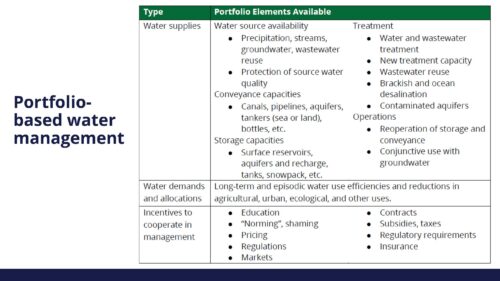 Another aspect of dealing with variability and the risks in water supply are the actions that we take.
Another aspect of dealing with variability and the risks in water supply are the actions that we take.
Water managers in California, particularly larger water systems, take a portfolio approach and do several things. These include surface water, groundwater, conjunctive management of surface water and groundwater where wet year water is stored in groundwater basins, managing demands, water conservation, both permanent and episodic, recycled water, and water markets – all the actions are listed in the table.
California’s water systems are complex; they can involve the Delta and a lot of entities, so there needs to be incentives to get everybody to cooperate. So part of the portfolio is how to induce everybody to get along well enough so that you can move forward and perform fairly well for both human and ecosystem purposes.
Supply reliability versus system performance reliability
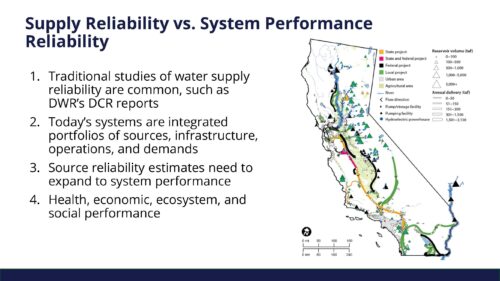 Since 1914, folks have been trying to estimate water supply reliability by calculating the numbers to come up with probabilities and quantifying reliability. The idea became fairly mainstream in parts of California water starting in the 1980s.
Since 1914, folks have been trying to estimate water supply reliability by calculating the numbers to come up with probabilities and quantifying reliability. The idea became fairly mainstream in parts of California water starting in the 1980s.
The Department of Water Resources publishes a biannual water supply reliability assessment for the State Water Project, which gives contractors the probabilities and distributions of how much the water they will get from the State Water Project, which Dr. Lund said has been an interesting and useful document over time.
However, with an integrated portfolio of activities, water managers are interested in how several water supplies will perform, how reliable they are, and how they can be matched with other programs, such as water conservation, water trading, and other agreements.
“You’re interested in the system performance reliability much more than the reliability of a single supply,” said Dr. Lund. “For the Delta, this is vitally important because most people and most uses using Delta water are also using other water sources, so they can also manage their demands and buy or sell water. So how that all works together is pretty important.”
“I think that’s how some of the most advanced systems in the state view this problem: performance reliability, rather than source reliability only,” he continued. “Source reliability is part of performance reliability. But what we really want to measure is how well the system performs for the purposes we have in mind. Why are we doing this? It’s not water for water sake; it’s water for public health, economic purposes, ecological purposes, and social purposes.”
Findings
There were three major categories of findings:
Water Supply reliability and its estimation serve human and ecosystem success in this highly managed system that will always be highly managed. “We’re going to have to make improvements for changes that are going on in the system in terms of climate, change in the ecosystems, changes in regulations, changes in water demands, and the kinds of extreme events that we want to be prepared for,” Dr. Lund said.
Water supply reliability requires managing many risks and uncertainties and improving management systems. “The analysis requires managing many different risks, not just climate,” he said. “We have changes in ecosystems that affect things; we have mechanical things that can go wrong; we can have floods that can collapse levees that can change the water quality in the Delta – a lot of different things. So we want to use this kind of analysis to help us integrate diverse activities look at both a probabilistic playing the odds kinds of analysis, but also preparing ourselves for surprises and extreme scenarios.”
Communication and integration of reliability analyses can better structure deliberations. “An important part of water supply reliability is not just the analysis; it’s the decision making,” he said. “So it’s not just the pointy heads with the calculators like me, but it’s the decision makers and how prepared they are to absorb and use that kind of information in their deliberations. So one of the difficulties, I think, is to cross this sort of cultural and contextual gap between the people who do the numbers and the people who need the insights from the numbers.”
Recommendations
1. Water supply reliability studies should reflect portfolio-based analysis to improve water management among diverse entities. We need to move from reliance on source reliability studies to performance reliability studies, Dr. Lund said, noting that Metropolitan, San Diego, and many other large urban water utilities have been moving in this direction for some time.
2. Water system reliability assessments should include public health, economic, ecological, and social performance.
3. More formal quality control and documentation should be encouraged and sometimes required.
4. A common State water accounting system would improve analysis quality, comparability, and clarity. Dr. Lund noted that different bodies are doing different analyses with different data that nobody else can understand because this is complex. “It would help if we were using the same kinds of numbers,” he said.
5. Updated water system models should be overseen by state and federal agencies and external experts. “This is always a moving target. The system here is always changing, so the models always need to change. As we update these models, we need to have more common efforts to have the different state agencies get together to have common datasets and modeling that will achieve a wider variety of purposes. So we don’t have to do an analysis, rerun it with five different agencies, five different consulting firms, five different contracting, time delays, and then you get results, and you have five different answers. As they say, a person with one has one watch knows what time it is; a person that has two watches isn’t sure.”
6. Performance metrics and analysis methods for environmental water supply reliability should be further developed and used. “In particular, we need to integrate ecological and environmental performance more firmly into water supply assessments. We’re making very expensive decisions. Some of them might not work, many of them won’t work, so we need to have some assessments of how often they’re likely to work and what the risks are so we can better manage and better prepare for contingencies when things don’t go the way we’d hoped.”
7. Estimation methods should be updated to reflect accumulated and expected climate changes, with uncertainty analysis. Even with climate change, the report lays out several different areas where there is uncertainty in the calculations and estimations.
8. Research and education needed to improve water supply reliability estimation practice and maintain expertise in government agencies. “Just as you want to have good legal counsel to go through the legal aspects of things, you want some technical experts that can help you understand the water supply reliability, not only for traditional water supply but also the environmental water supply along with the scrutiny and reliable insights needed for decision making.”
Challenges
Challenges include preparing for changes in the system due to climate change and other factors. Ecological performance needs to be improved. Communications and insights from these elaborate calculations should be integrated into decisions. Hopefully, in the end, the analyses and discussions help us play the odds better for these difficult problems and prepare for the extremes and the surprises that will occur.
“We have some advice in the report on preparing for surprises,” said Dr. Lund. “A surprise is a scenario you didn’t expect. And coming out of the pandemic, I think we’re all aware of just how big these surprises can be and how important they are to prepare for.”
Potential implications
Dr. Lund said this has potential implications for all state agencies, local agencies, and water users. He then gave three examples for the Stewardship Council.
The Stewardship Council might consider including in the Delta Plan elements on the management of extremes, particularly drought. “Droughts are when we tend to lose species. Droughts are tend to be when we see the big water supply costs and water quality applications; maybe you should think about how that kind of an element might be crafted and integrated into the Delta Plan. Because ultimately, that’s where the rubber meets the road in a lot of cases with all this variability we see.”
“Perhaps the Council might want to consider requiring or “should-ing” a water supply reliability impacts statement as part of consistency determinations under the Delta Plan covered actions,” he continued. “The Council might consider taking the lead and instigating collaboration among the agencies, similar as envisioned for the Science Program under the legislation to develop more common formal methods for water supply reliability estimation.”
DISB Board Member Dr. Thomas Holzer added that it’s important to realize that nature is random. “We’re talking about the tools for including that in decision making. These models become complex in a hurry. And there are assumptions hidden in it that become barriers to communicating. You get output from one of these models, but it should only be looked at as guidance, not as a definitive prediction of what the future holds. This is a very important issue for the Delta. And at least from the Delta Stewardship Council’s perspective, we haven’t focused on very much this reliability issue.”
“These extreme events come along and have tremendous impacts on the systems and droughts,” Dr. Holzer continued. “Earthquakes fall in those categories. And then there are the longer-term events like sea level rise that will drastically change the Delta over decades and centuries. So we have to be aware that that’s reality; that’s part of that randomness in nature.”
“We often neglect the positive implications that come out of these extreme events,” noted Dr. Lund. “They motivate us; they get our attention. They provide the political will and attention to make improvements. So if you look at the history of California water, of the Delta, of earthquakes – the improvements tend to come out of the failures and the shortcomings that these extreme events highlight.”
Read more about water supply reliability by clicking here.
2022-06-16-isb-water-supply-reliability-review

